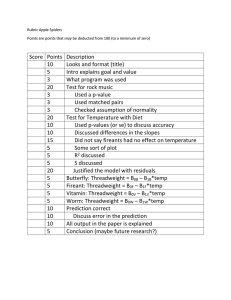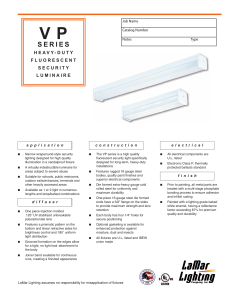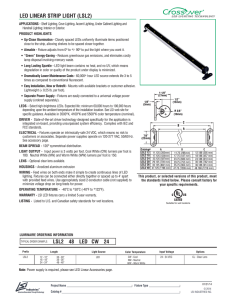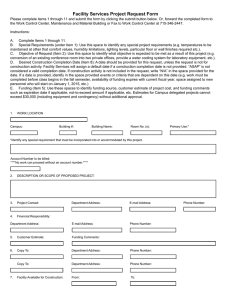They`re Just Lights… Right?
advertisement
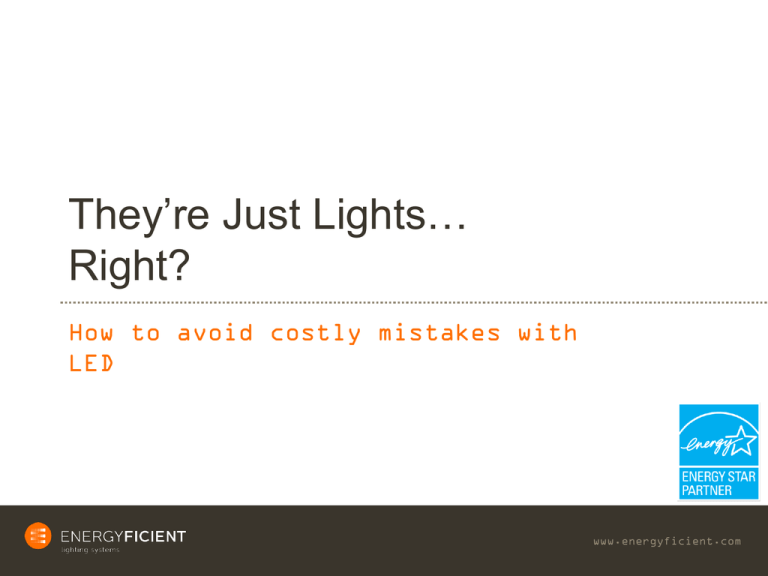
They’re Just Lights… Right? How to avoid costly mistakes with LED www.energyficient.com Choices at Home If it fits it will work? What’s the worst that can happen? www.energyficient.com Choices at Work If it fits it will work? What’s the worst that can happen? www.energyficient.com The Good ‘ol Days Decisions were Simple www.energyficient.com Old Lighting Metrics • Light Output – Referred to as “Watts” • Lamp Life - “Average Hours of Life” • Base SizeBayonet, Medium, Candleabra, Intermediate, DC and Mogul bases. • Initial Lumens - Light output the first time you turn on a lamp. • Mean Lumens lamp life. Light output at 40 or 50% of the www.energyficient.com New Lighting Metrics • Light Output – Lumens • Beam Angle Distribution6° • Kelvin Temp (CCT) 2700K, 3000K, 4000K, 5000K, 6500K • Color Rendering (CRI) • Glare source hinder reduce safety? 120°, 180°, 280°, 360°, 60, 70, 80, 90 Will the direct glare of the light your work or • Temperature Ratings bulb was The ambient temperature your LED intended for. • Rated Life When your LED will lose 30% of it’s light output. When used at the specific temp and conditions it is designed for. • Certifications- www.energyficient.com Lighting 101 What makes lighting fail? Vibration/Shoc k Voltage Water Heat www.energyficient.com HEAT Typical Max Temp Ratings 25/77°C/F 25/77°C/F 70/158°C/F www.energyficient.com HEAT Typical Max Temp Ratings 40/104°C/F 55/131°C/F 65/149°C/F UL Listed for damp locations for locations not exceeding 40°C (104°F) ambient temperatures www.energyficient.com HEAT Typical Max Temp Ratings • Advertised with 85+C max temp • Has a fan – great idea, bad for enclosed fixtures • Air temp will climb over max in enclosed fixture www.energyficient.com HEAT READ the FINE PRINT ***In enclosed fixtures, ensure the lamp has enough space for heat dissipation. This will ensure lumen maintenance and extend its working life. When products are used in outdoor fixtures, ensure the space is waterproof and well ventilated. If there is a ballast in the existing fixture, simply disconnect or bypass when installing Corncob LED retrofit lamps. www.energyficient.com HEAT Rated Max Ambient Temps 10°C 18°F Lose 50% of Advertised Life 10°C 18°F Gain 50% in Advertised Life Rise over Rating Rise over Rating www.energyficient.com HEAT The Math 25/77°C/F 65/149°C/F + = 35/95°C/F 95/203°C/F Over Temp 70/126°C/F Life Reduction .0078 or 1/128th www.energyficient.com Heat Applying The Math Type MAX Test Temp Temp Affect On Life Rated Life Actual Life CFL Screw in 25 95 1/128th 10,000 78 Hrs LED Screw in 25 95 1/128th 35,000 273 Hrs Agrificient LED 70 35 +175% 60,000 135,000 Hrs www.energyficient.com What They Don’t Tell You LED’s have a ballast! They have cleverly disguised it with a new name. These “drivers” doesn’t last any longer than the “ballasts” we are all accustomed to. Actual life will vary based on ambient temps. “Driver“ Life will vary based on ambient temps. Courtesy of Lighting Research Center research paper “Accelerated Life-test Method for LED Drivers (2011)” www.energyficient.com What They Don’t Tell You Published light output is typically based on 25°C. The light output you see on the bench isn’t what you will get in practice. Courtesy Cree “LED Luminaire Design Guide” www.energyficient.com Today’s Decisions, Yesterdays Method Your poor, poor maintenance budget… • New Product– Introduced to sales through brochure or maybe a lunch and learn. • Routine Visit Distributor sales person introduces new product to maintenance staff. • If it fits it works- No one is trained enough to be certain the new product will actually do the job, so they do trial install or worse, they plug it in on the bench. • Decision Made- Based on appearances, and light output and what the brochure says. • Budget DrainedThis process slowly drains your maintenance budget of resources. Trial and error is not the way to do this. www.energyficient.com Mistakes Are Easy to Make Warehouse Application: Which one do you choose? $1100 $700 $300 $300 www.energyficient.com Mistakes Are Easy to Make Warehouse Application: Which one do you choose? $150 www.energyficient.com Best Practice Understand your application needs Ambient Temperature Environmental factors such as water, gases, vapors, dust, etc. Desired light levels, in FC (not in lumens or watts) Hours of Operation Difficulty of maintenance Understand your goals and priorities Energy savings Improved safety Glass removal mandate Maintenance cost reductions www.energyficient.com Do’s and Don’t’s Do: • • • • Consider multiple designs and manufacturers Use fixtures with replaceable LED boards/modules Buy fixtures engineered for your specific application Consider all available technology for your application, even HPS! • Read the fine print Don’t: • Choose LED fixtures with proprietary ballast designs unless throwaway unit • Use the trial and error method of choosing the right fixture or tech • Choose LED just for the sake of using LED • Listen to sales people and marketing • Leave it up to chance to spend your money wisely www.energyficient.com Other Considerations • Ease of Installation? How much trouble will it be to install? •Safety Tested? UL, ETL, etc •Energy Star or Design Lights Certified? •Ratings? Indoor, Outdoor, Wet Location, Damp Location, NEMA 4X •Durability? Will it take a beating? •Corrosion Resistance? •Warranty? www.energyficient.com
